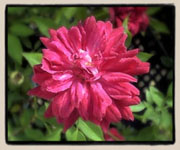 |
|
Albas |
OUT OF CHINA by
Ralph S. Moore
2519 E. Noble Avenue Visalia, CA 93292 We
have all heard the oft repeated story that miniature roses (as we now
know them) trace back to Rosa rouletii. But this story is only partly
true. 'Tom Thumb' (Peon in Europe), by
Jan de Vink, came from the first cross using rouletii, soon to be followed
by others.
Rouletii is apparently a pure china rose and the first hybrids were mostly crosses of a polyantha variety X rouletii. But there is more. In my own work, I began by crossing (a then unnamed rose) 'Carolyn Dean' with 'Tom Thumb' to produce 'Zee'. And 'Zee' in turn became the pollen parent of a whole tribe of miniatures including 'Pink Cameo', 'New Penny', 'Sheri Anne', 'Magic Wand', 'Fairy Princess', 'Mary Marshall', 'Yellow Doll', 'Little Chief' and many more.  There
is yet another side to the miniature story. About 1940-41, I used pollen
of 'Floradora' on 'Oakington Ruby'
which was a 'found' rose in England and introduced by Robinson. This
also appears to be a pure china, more red, more double and more vigorous
than rouletii. At about the same time I had acquired plants of Rosa
wichurana and proceeded to cross it with Floradora (a new orange-red
floribunda from Germany).
From this crossing I raised some 50 or more plants which I grew to flowering
stage. They ranged in color from white to pink. Flower size was about
1 and 1/2
to 2 " with 5 to 10 or more petals. From the lot I selected one plant
which in my breeding became #0-47-19. This variety (cultivar) was propagated
into numerous plants to be used in my breeding (but never introduced). There
is yet another side to the miniature story. About 1940-41, I used pollen
of 'Floradora' on 'Oakington Ruby'
which was a 'found' rose in England and introduced by Robinson. This
also appears to be a pure china, more red, more double and more vigorous
than rouletii. At about the same time I had acquired plants of Rosa
wichurana and proceeded to cross it with Floradora (a new orange-red
floribunda from Germany).
From this crossing I raised some 50 or more plants which I grew to flowering
stage. They ranged in color from white to pink. Flower size was about
1 and 1/2
to 2 " with 5 to 10 or more petals. From the lot I selected one plant
which in my breeding became #0-47-19. This variety (cultivar) was propagated
into numerous plants to be used in my breeding (but never introduced).The variety 0-47-19 has clusters and sprays of one and one-half inch single, soft pink, blended with yellow, flowers which have a sweet wild rose scent, has a true rambler habit with glossy foliage and spring bloom. Over the years I have used this rose as seed parent in hundreds of crosses and combinations. Of equal importance in the miniature story is the cross I made of 'Oakington Ruby' X 'Floradora' from which also one seedling was saved. This plant was a vigorous upright grower with very double 1 and 1/2 " red flowers. It produced a little pollen which I used on 0- 47-19 many times. From the first crosses came such varieties as 'Dian', 'Little Buckaroo' and 'Westmont'. They were followed by 'Red Germain' and others. But the important "stars" were 'Westmont' and 'Red Germain'. These two were to change the story of miniature roses forever. Two other happenings were my discovery of the yellow climber 'Golden Glow', from Brownell and 'Little Darling' from Carl Duehrsen. I had ordered a plant of 'Golden Glow' from Walter Brownell which was doing well so I grew several more. This rose is a vigorous climber to about 15 feet with good foliage and large 4" double yellow flowers. It also sets seed hips easily and seeds germinated well. However, it is only a spring flowering variety so pollinizing must be done over a short period of time. And I discovered that it carried the recessive factor for repeat bloom. Then the stage was set for some improved yellow miniatures, plus white, cream and bi-colors. Over the years I proceeded to make many hundreds of crosses and grew thousands of seedlings of various combinations using 'Golden Glow' as the seed parent. The majority of the seedlings were once blooming climbers which were soon discarded. But there were numerous dwarf repeat flowering bushes. From these, such new varieties as 'Easter Morning', 'Jackie', 'Yellow Doll' and 'Little Flirt" came to be. There were also a few repeat flowering climbers of which two were finally selected, namely 'Climbing Jackie', a creamy white, and 'Little Showoff', a red and yellow bi-color. All the above miniature varieties were from crosses of 'Golden Glow' X 'Zee'. How such a small, rather weak plant such as 'Zee' (really a tiny miniature climber to about 14 inches) could pair with the huge vigorous climber, Golden Glow', and give such offspring as 'Easter Morning' and 'Yellow Doll' is truly a miracle.
Along with the breeding using 'Zee' as the pollen parent I began to
use some of the (R. wichurana X 'Floradora') x ('Oakington
Ruby' X
'Floradora') seedlings. Those proving best were 'Westmont' and 'Red Back to rose breeding articles Original photographs and site content © Paul Barden 1996-2002.
There
have been |
|

